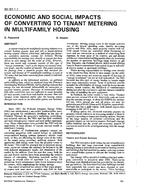
NY-91-01-1 — Economic and Social Impacts of Converting to Tenant Metering in Multifamily Housing
- Comments Off on NY-91-01-1 — Economic and Social Impacts of Converting to Tenant Metering in Multifamily Housing
- ASHRAE
A current trend in the multifamily housing industry is to convert heating systems (gas and oil) to tenant metered heating systems (electrical zonal heat, individual gas furnaces, secondary metering systems for boilers). Moving responsibility for heating costs directly to tenants has been shown to save energy (on the order of 15%). However, there are social and economic aspects of this type of “energy investment,” such as the impact on vacancy rates, rent levels, and the comfort of tenants. Presents the findings from a research project that surveyed the owners and tenants of 37 multifamily buildings (a total of 741 units) that had been converted from central to individual metering. In addition to the behavioural analysis, we gathered utility billing data, which we analysed using the Princeton Scorekeeping Method (PRISM). Survey findings indicate that energy use was decreased substantially by conversion to separate heating systems. Increases in tenant-paid utility bills after conversion were not sufficient to cause hardship for most tenants, even those with modest incomes. Rent and vacancy levels remained stable after the heating system changes were made or an allocation system was installed.
KEYWORDS: economics, flats, metering, energy consumption, energy conservation, housing, heating, sociology, decentralisation, tenants, heat meters
Citation: Symposium, ASHRAE Transactions, vol.97, Pt. 1, New York 1991
Product Details
- Published:
- 1991
- Number of Pages:
- 5
- File Size:
- 1 file , 780 KB
- Product Code(s):
- D-18353

